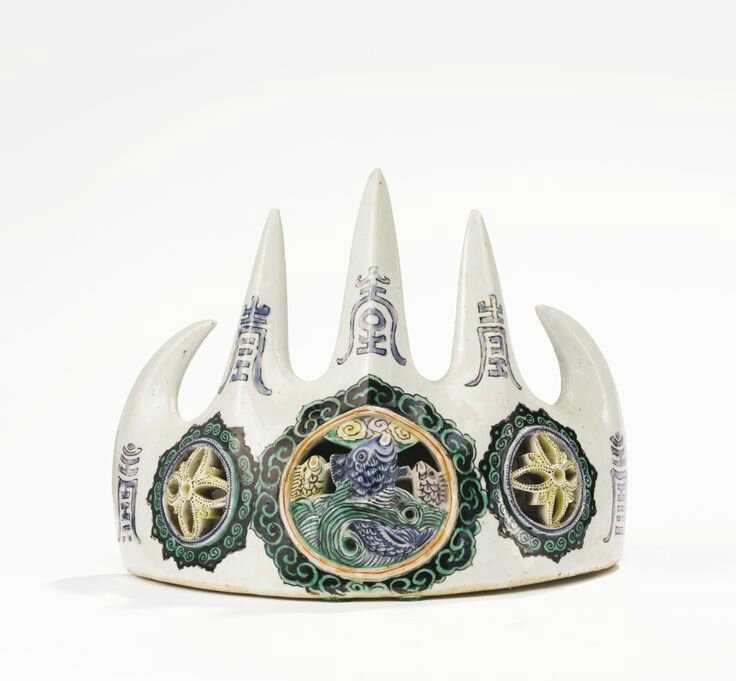A susancai openwork mountain-form brushrest, Qing dynasty, Kangxi period (1662-1722)
A susancai openwork mountain-form brushrest, Qing dynasty, Kangxi period (1662-1722). Length 6 3/4 in., 17.1 cm. Photo Sotheby's
Provenance: Collection of George R. Davies, United Kingdom, (1843-1918).
Sotheby’s Hong Kong, 26th October 1993, lot 131.
S. Marchant & Son, London, 1993.
Exhibited: Museum of Fine Arts, Boston, The Colors of Earth, Kangxi Era Porcelain from the Stamen Collection, 2002, no. 15.
Literature: Burlington Fine Arts Club Exhibition of Coloured Chinese Porcelain, London, 1896, no. 91.
Collection of Old Chinese Porcelains formed by George R. Davies, Esq, Gorer, London, 1913, p. 60, no. 265.
Note: Functionally well-designed to accommodate four brushes, the form of the present piece also conjures up immediate reference to the Five Great Mountains or Wu Yue. These peaks, famous natural landmarks, had since at least the Warring States been designated as sacred destinations. Literal heights are synonymous with spiritual ascendance. In addition the openwork design features a carp leaping upward through roiling waters; a symbol of scholarly perseverance. Longevity characters punctuate the peaks and the reverse, adding to the overarching inspirational message of the deep spiritual satisfaction born of long-lived intellectual pursuit.
Brushes, used for painting and calligraphy, the two highest art forms of Chinese culture, were valued scholarly possessions. The context in which art was created was conscientiously composed to encourage lofty thoughts and brilliant brushwork. This concept of scenic display is termed weizhi, or the art of relative arrangement. Books by two famous late Ming dynasty arbiters of literati taste, Wen Zhenheng'sTreatise of Superfluous Things (1620-1627) and Li Yu's Casual Expression of Idle Feeling (1671) explore the art of arrangement at length opining that table displays should be spare and the objects should be arranged asymmetically.The Qing aesthetic, reflective of the rise of a powerful and wealthy merchant class, tended towards more lavish presentation with a greater variety of objects and further highlighting them by presenting works of art on custom fitted stands.
The present piece was previously owned by George Reynolds Davies (1843-1918) who amassed one of the most important collections of Chinese porcelain in the West at the turn of the 20th century. According to Roy Davids and Dominic Jellinek, Provenance, London, 2011, Davies was a fierce rival of George Salting, a great friend of Richard Bennet’s and something of a dealer, frequently auctioning items anonymously, ibid, p. 139. In 1896, Davies lent seventy-seven pieces to the Burlington Fine Arts Club Exhibition; among which the present brushrest. In 1913, the collector sold his collection, 943 pieces, to Edgar Gorer for the reported sum of £220,000, ibid p. 141. That same year Gorer took the collection to New York City for exhibit at Dreicer & Co, and where several pieces were acquired by Benjamin Altman, who later bequeathed his collection to the Metropolitan Museum of Art, New York. Sotheby’s would like to thank Professor Nick Pearce, University of Glasgow for providing the biographical data for Mr. Davies.
Sotheby's. Embracing Classic Chinese Culture: Kangxi Porcelain from the Jie Rui Tang Collection, New York, 14 march 2014

/https%3A%2F%2Fprofilepics.canalblog.com%2Fprofilepics%2F1%2F0%2F100183.jpg)
/https%3A%2F%2Fstorage.canalblog.com%2F03%2F02%2F119589%2F96711876_o.jpg)
/https%3A%2F%2Fstorage.canalblog.com%2F11%2F31%2F119589%2F94773502_o.jpg)
/https%3A%2F%2Fstorage.canalblog.com%2F20%2F83%2F119589%2F94772815_o.jpg)
/https%3A%2F%2Fstorage.canalblog.com%2F26%2F72%2F119589%2F75604929_o.jpg)
/https%3A%2F%2Fstorage.canalblog.com%2F59%2F60%2F119589%2F26458628_o.jpg)



/http%3A%2F%2Fstorage.canalblog.com%2F76%2F61%2F119589%2F118867846_o.jpg)
/http%3A%2F%2Fstorage.canalblog.com%2F83%2F36%2F577050%2F39211685_p.jpg)
/http%3A%2F%2Fstorage.canalblog.com%2F71%2F91%2F119589%2F30056120_o.jpg)
/image%2F1371349%2F20240423%2Fob_af8bb4_telechargement-6.jpg)